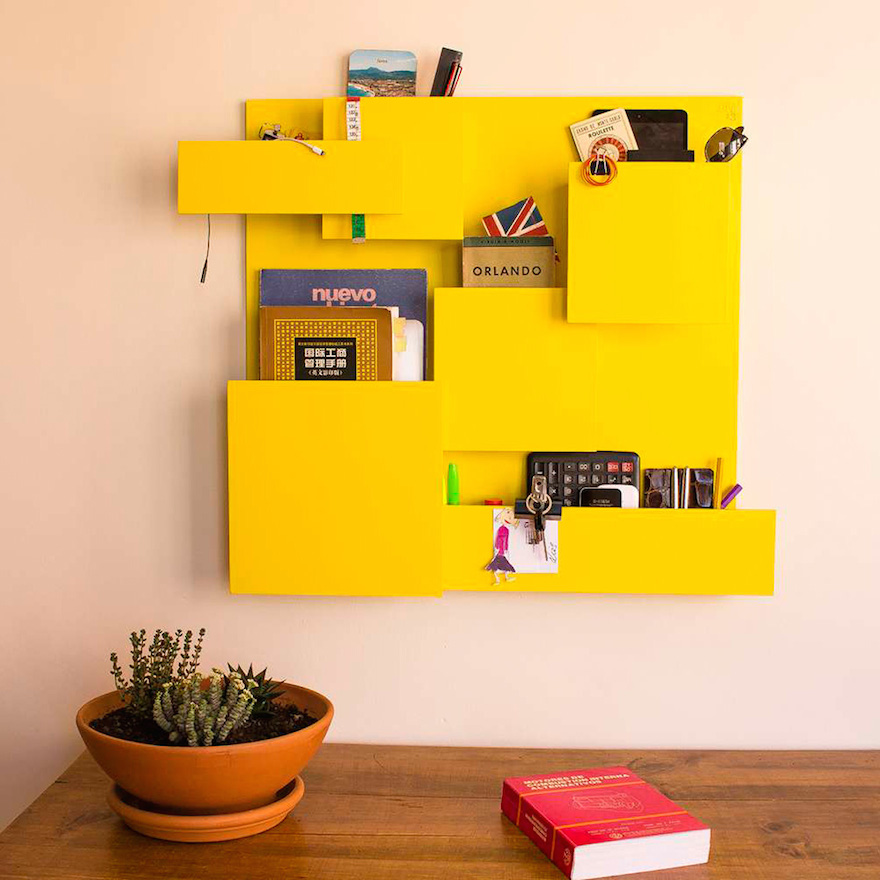Making the Most of Wall Space, Part 2

We've talked about using the walls to keep papers close at hand, and to store knives—but walls can be used to store all sorts of odds and ends.
One way to use the walls is with a pegboard; Julia Child's kitchen pegboard, where she hung her copper pots, is a famous example. The pegboard above, from Human | Crafted, takes this old standard and makes it decorative as well as functional. The board is CNC machined from a solid block of walnut; the loops and hooks are 3D-printed nylon. It also comes with five feet of bungee cord, providing one more way to hold items in place.

Droog's Strap, designed by NL Architects, is another example of taking a familiar product—in this case, the straps used to hold luggage on the back of a bike—and doing something new with it. The straps are made from silicone rubber and can hold phones, keys, remotes, books, hand tools, etc. These would work great for end users who work best when everything is clearly visible. But for others, it will add visual clutter.

The naoLoop Loft, with its polyester latex bands, follows the same general approach as the Strap, but with the bands attached to a laser-cut stainless steel (or powder-coated steel) board. Besides transforming the look, the board protects the walls from anything that might get them dirty or cause other damage.
 Photo: Michael Wilson
Photo: Michael WilsonThe Hanging Line from Kontextür, designed by Josh Owen, is a single silicone band. Items are stored by tossing them over the line, or hanging them from a hook. Although this was designed for bathroom use, end-users could certainly use it other places, too. It's somewhat limited in what it can hold, much more so than the Strap or the Loft—but it certainly provides more storage options than the standard towel rack.

It would be hard to write about wall storage without mentioning Vitra's Uten.Silo, designed by Dorothee Becker in 1969; a smaller version came out the following year. With containers of all sorts of shapes and sizes, plus some hooks, the Uten.Silo will keep a wide range of things close at hand, and easy to find.
 Photo: Mathias Nero
Photo: Mathias NeroSeletti's Suburbia, from Note Design Studio, was obviously inspired by Uten.Silo. The look has been changed to resemble a town, viewed from overhead; it's also made of wood, rather than plastic. But from an organizing standpoint, what caught my eye was that Note added some shelves and a cork board, providing yet more storage options.

The Luis Organizer from Oli13, made from MDF, has fewer, larger containers—so it's good for books, notebooks, etc. However, it would be easy for smaller things like pens to get lost in those pockets.

The Stash, from Boon, can be used either on a countertop or on the wall; that's a nice bit of flexibility. (The HYVE, which we wrote about before, has somewhat similar flexibility.) While the Stash was designed to help control kid-related clutter, it can be used for much more.

All of the products I've mentioned so far have one limitation: The end user is stuck with one configuration, with no choice as to the number or size of the containers. But designers have created a number of individual pockets for those who want to create their own configurations—or who need (or only have space for) a limited number of containers. CB2's wall pockets have one drawback: the mounting hardware is visible. But functionally, they're a winner.

Ampersand's wallpockets are made from recycled paperboard and can be hung with wall adhesive or roofing nails. The wallpockets ship flat; they have integrated notches to make them easy to assemble. They're also reversible.

We've mentioned the Urbio indoor vertical gardening system before, but Urbio seems to have realized that its system can be used for more than gardening. With magnetic wall plates and four different polypropylene containers to go onto those plates, the Urbio system lets end users create the mixture that works best for them. And if users want to save money and don't need a custom solution, they can buy one of the two kits that Urbio provides.

The polypropylene Pocket from Normann Copenhagen, designed by Simon Legald, comes in four sizes and six colors, so it gives end users a lot of choices. As Legald says, "The different sizes of Pocket mean that it can easily be adapted to suit individual needs." The Pocket comes with a sliding mounting bracket that's invisible once it's been mounted on the wall. It can also be placed in the dishwasher, which will please many end users.
-
oFavorite This
-
QComment
K
{Welcome
Create a Core77 Account
Already have an account? Sign In
By creating a Core77 account you confirm that you accept the Terms of Use
K
Reset Password
Please enter your email and we will send an email to reset your password.

